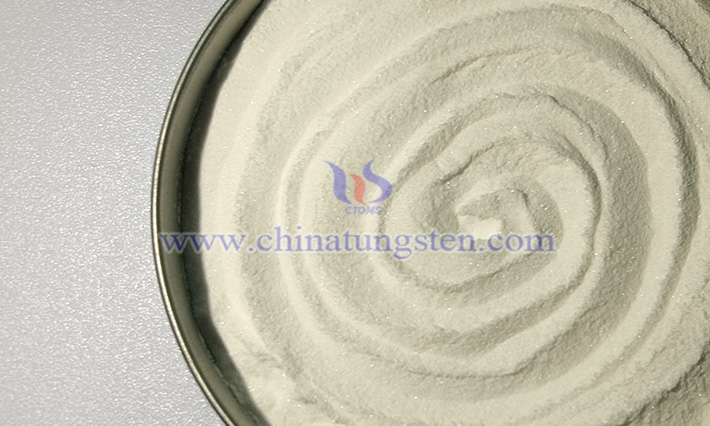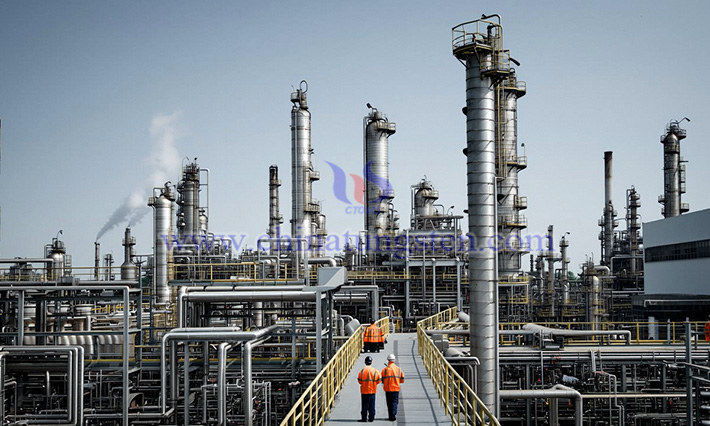The Invisible Force in Petroleum Refining: How Ammonium Metatungstate Shines
- Details
- Category: Tungsten Information
- Published on Wednesday, 30 April 2025 19:25
Petroleum, often dubbed the “lifeblood of industry,” is a complex mixture of hydrocarbons in its crude form, requiring refining to unlock its full potential. Petroleum refining, akin to a magical transformation, converts crude oil into valuable products like gasoline, diesel, and lubricants, which permeate every facet of modern life. In oil-rich nations, refining is a cornerstone of the economy, driving significant growth. However, this intricate process demands advanced technologies and efficient catalysts to ensure smooth operations and consistent product quality. Among the unsung heroes, CTIA GROUP LTD’s Ammonium Metatungstate (AMT) stands out as a critical catalyst precursor, quietly enabling high-efficiency petroleum refining.

I. Understanding Ammonium Metatungstate: The Unique Profile of a Mysterious Powder
Within the vast family of chemical compounds, Ammonium Metatungstate (AMT) is a discreet yet powerful player. Though less familiar to the public, it is indispensable in industrial applications, particularly petroleum refining. AMT, with the chemical formula H28N6O41W12, appears as a white crystalline powder, sometimes with a slight yellowish tint. Its excellent water solubility allows it to form uniform solutions, making it ideal for applications in coatings, catalyst supports, and more.
CTIA GROUP LTD’s AMT features a Keggin-type polyoxometalate structure, characterized by a large specific surface area and abundant active sites. This structure provides ample space for reactant molecules to adsorb and react on its surface. Additionally, its anionic “pseudo-liquid phase” property allows reactant molecules to diffuse freely within its structure, accelerating reaction rates and enhancing catalytic efficiency.

Compared to traditional catalysts, AMT offers milder reaction conditions, ease of separation and recyclability, and sustained performance over multiple uses without significant degradation. These qualities reduce production costs and waste, aligning with green chemistry principles and making AMT highly promising for sustainable industrial processes.
II. AMT’s Critical Role in Petroleum Refining
In the complex ecosystem of petroleum refining, AMT serves as a behind-the-scenes hero, playing pivotal roles across various stages to ensure efficient, high-quality production.
1. Powerful Catalytic Function
AMT’s primary contribution lies in its role as a catalyst, accelerating key chemical reactions in refining:
Cracking Reactions: Cracking breaks long-chain hydrocarbons into shorter, more valuable molecules, essential for producing gasoline and diesel. Traditional cracking requires high temperatures and pressures, resulting in slow reaction rates and low efficiency. AMT lowers the activation energy, enabling faster reactions under milder conditions, thus boosting productivity.
Reforming Reactions: Reforming transforms low-octane gasoline fractions into high-octane products, improving fuel quality. AMT catalyzes isomerization and aromatization, increasing the content of aromatics and iso-alkanes in gasoline, thereby enhancing its octane rating.
2. Enhancing Oil Quality
Crude oil contains impurities like sulfur and nitrogen compounds, which impair combustion performance and generate pollutants during burning, harming the environment. CTIA GROUP LTD’s AMT significantly improves oil quality by facilitating impurity removal:
Desulfurization: As a catalyst in hydrodesulfurization, AMT promotes reactions where sulfur compounds in oil react with hydrogen to form hydrogen sulfide, which is then separated. This process efficiently reduces sulfur content to ultra-low levels, producing cleaner fuels.
Denitrogenation: AMT catalyzes hydrodenitrogenation, converting nitrogen compounds into ammonia and other harmless substances. Lower nitrogen content reduces nitrogen oxide emissions during combustion and enhances fuel stability and storage life.

3. Reducing Production Costs
For refineries, controlling production costs is vital for competitiveness. AMT contributes to cost reduction in several ways:
Improved Reaction Efficiency: AMT accelerates reactions, allowing desired outcomes in less time. This increases equipment utilization and overall production efficiency, enabling higher output within the same timeframe.
Lower Energy Consumption: By enabling reactions at reduced temperatures and pressures, AMT decreases energy use, a significant portion of refining costs, directly lowering operational expenses.
Minimized Raw Material Waste: AMT’s high catalytic efficiency ensures more complete reactions, reducing raw material losses due to incomplete conversions. It also improves product quality and yield, allowing refineries to produce more high-quality products from the same raw material input, further reducing per-unit costs.
- Chinatungsten Online: ammonium-metatungstate.com
- CTIA GROUP LTD: en.ctia.group
- Tungsten News & Price: www.ctia.com.cn
- Molybdenum News & Price: news.molybdenum.com.cn
- Tel.: 86 592 5129696; Email: sales@chinatungsten.com



 sales@chinatungsten.com
sales@chinatungsten.com